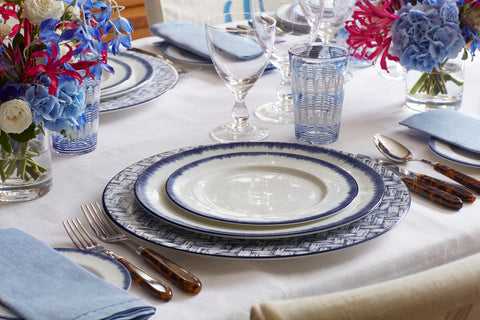An Interview With Nina Campbell, Interior Designer
A true doyenne of interior design, Nina Campbell is as highly regarded as she is well known. In the UK her trade, somewhat appropriately, has made her a household name, and working all around the world, she has lent her uniquely scrupulous eye to clients from Ringo Starr to the Royal Household. In 2021, her company celebrated its 50th anniversary. As a fellow long standing British brand, we were thrilled to collaborate with Nina in releasing two beautiful ranges of fine bone china: the Serengeti and Marguerite collections. A year on from the release of those two collaborations, we sat down with Nina to discuss British craft, styling tips, and acid green tablecloths. Read part of our conversation below.

HD: As the founder of a great British brand, what does Britishness mean to you from a design perspective?
NC: Most importantly, it means quality. English crafts like making fine bone china are so important to hold onto. I use and own china from all around the world, including France and Italy, but there is something completely different about English fine bone china and that is to be celebrated.
HD: Since 2010, you’ve made your own furniture to complement your interior design work. Like ours, your pieces are made here in the UK by expert craftspeople. Was that important to you when you moved into that new sphere of manufacturing?
NC: Yes it was. One really wants to support British craftsmanship and British trade as much as possible. Keeping craftsmanship going in England is very important.
HD: Are there any other British designers past or present that you particularly admire?
NC: Lulu Lytle at Soane is doing a fantastic job, again, supporting English craftsmanship. I collect Kate Malone’s work and various other ceramicists. I greatly enjoy getting to know the creators behind the pieces I own too.
HD: Your company celebrated turning 50 last year. In that time, has your approach to your work, or indeed your taste changed at all?
NC: The pace has accelerated significantly. I don’t think my core values have changed but I hope that I have moved with the times. One doesn’t want to stick completely with the same thing, though we still sell a few things in our shop that we have sold almost from day one. Everything is cyclical, it’s rather nice when you get the children (of previous clients) coming in and saying “oh my parents had this” or “my grandmother had this” and so on.
HD: That idea of generational continuity is certainly something we value greatly as a brand too. I was also wondering about your process. Is there a particular stage of interior design that you most enjoy?
NC: Well, I think the most enjoyable bit is when the penny drops and you get to know exactly where you’re going with a job. The start of the journey is very exciting, as is getting to know your clients and figuring out exactly what they want. I’m lucky in having very diverse clients. Tomorrow I’m going to Jordan to see a house that I’m in the middle of doing which, of course, is completely different to working on a house in the North of England, or indeed in Maine where I’ve just come back from. What one person likes or is suitable for their house is not at all what another likes or is suitable for their house: that is what’s fun about it.
HD: How do you know when a room is finished?
NC: In a way, a room never is finished. It would stagnate if it was finished. One house that I did three years ago, I still keep in touch (with the owner) who will write to me saying “I’ve just seen these, where could we put them?”, so it’s a sort of ongoing story. I don’t think a house ever really ends, especially if people are collectors then of course they go on collecting, rejigging, and editing so that they can find places to put new objects.
HD: We’re soon set to release a selection of new pieces to our popular Serengeti fine bone china range which we released in collaboration with you last year alongside the beautiful Marguerite collection. What tips would you give for tablescaping?
NC: I’m constantly changing my table around. I had a big dinner last night and found an antique tablecloth which is white with open laced panels. I had an acid green under-cloth made which shows through the lace. I was in a wonderful shop the other day with so many linens you almost began to hyperventilate. I managed to control myself to an extent but I bought white napkins with a huge acid green ‘N’ on them and then I bought green ones with white lettering, so I like to set them alternately round the table.
It’s important to keep ‘shopping your cupboard’ too. Use things in different contexts and combinations to give them new life. It’s rather like with your clothes. Even putting an object on the table instead of flowers sometimes can work. A china ornament that might look very old fashioned on a mantlepiece can suddenly look great when it’s placed on the table. I think that the Serengeti collection looks very pretty mixed in with glass plates and blue glass and I love mixing and matching different pieces of fine bone china together.





